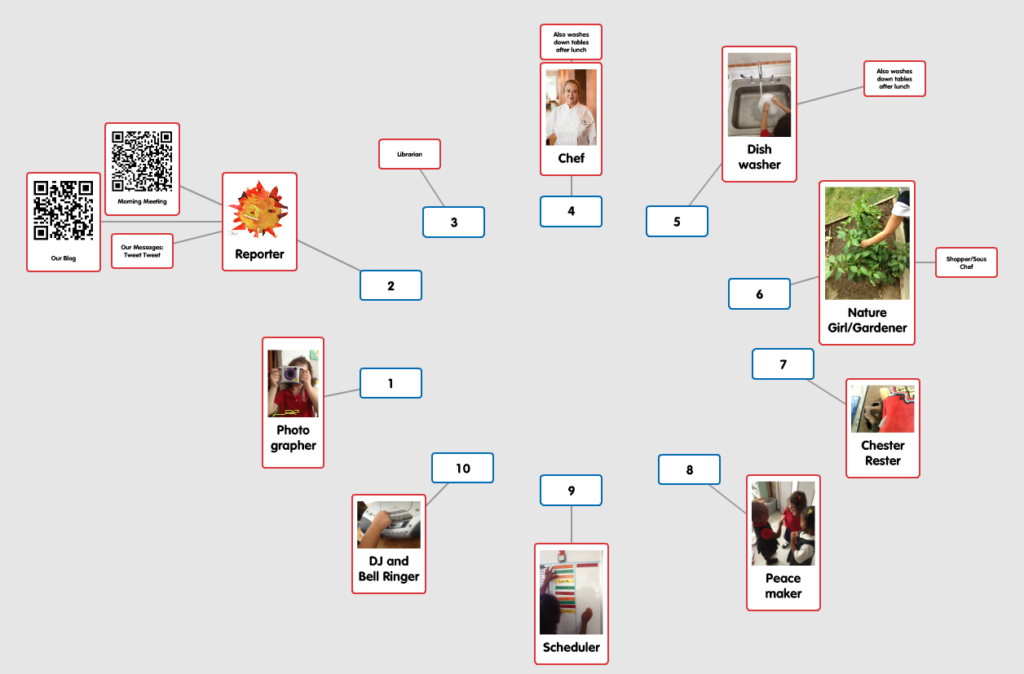It still surprises us that Popplet has as much of an eager following amongst kindergarten students as it does amongst creative professionals and business users! It really shouldn’t be such a shock to us:
- The ease with which you can start thinking visually with Popplet
- The ability to add your own text and images as you go
- The way you can incorporate links and content from around the web, and
- The collaborative features that make it so easy to work with others and share your ideas…
So, on reflection, the uptake of Popplet amongst kinder teachers and their classes makes sense. Last school year, the use of Popplet in kindergarten classes jumped dramatically, as those involved with the kinderchat peer network began to share lesson plans and classroom activity guides on using Popplet.
Kinderchat is a global network, with 17 international moderators who work together in teams to select topics and guide weekly discussions. It is already one of the most popular edu chats on Twitter (try searching for the hashtag #kinderchat), and is listed as 5th most ”liked” online community overall according to the US Dept of Education Connected Educators Directory.
 We spoke with Heidi Echternacht, Co-Founder of Kinderchat about how the online community has grown and how Popplet is being used in kinder classrooms around the world. (For those not involved in education or are involved at other age range or education modalities, we hope the story of Kinderchat provides some great insights into how to grow any online community.)
We spoke with Heidi Echternacht, Co-Founder of Kinderchat about how the online community has grown and how Popplet is being used in kinder classrooms around the world. (For those not involved in education or are involved at other age range or education modalities, we hope the story of Kinderchat provides some great insights into how to grow any online community.)
Q: Can you briefly outline the growth of Kinderchat over the past 3 years?
A: I have to say it’s been an amazing, exhausting, fun, lonely, hard, crazy, exciting journey! Amy and I outlined our Goals in June of 2010 and started up in September of that year. It was really hard at first- who is going to come? What if no one comes? How do I fill dead tweet air for AN HOUR?
At the first Kinderchat, Matt Gomez and Jon Fines found us! Or we found them?! Who knows! But we just were so excited to find other Early Childhood folks on Twitter. Back then it felt like everyone on Twitter was involved in the higher grades, consultants, celebrities or in business. The four of us will never forget that moment of finding each other!
Since then, we’ve experienced steady growth and now are one of the busiest educational hashtags on Twitter. There is always someone posting and almost 24/7 conversations taking place. I’m very proud of our community.
Q: Who were the first international classes to join and what was that like?
A: We were international from the very start, as Amy Murray, my co-founder is from Canada. So right off the bat we were comparing weather and laughing about various “American” or “Canadian” bits of culture (they do really love their hockey up there, they wear “toques” and really are some of the nicest people in the world – also STELLAR educators.)
Mr Ben from Indonesia was probably our first most exciting connection. I remember all of a sudden, the world just shrinking and there we were, coming all together at the same time but at all different times of the day. I’m still inspired by that thought!
Q: What are the main types of resources/supports early childhood educators are looking for?
A: Working in Early Childhood is a very lonely job. It’s a very hard job. It’s a job not all that well respected among many. It’s a job that requires a very special kind of person. That said, we need shoulders to cry on, cheerleaders, friends. We need connections and we need to be in dialogue – constant dialogue.
Q: Canadian Educator and Innovative Teaching Leader George Couros has praised Kinderchat’s social media engagement strategies: can you describe how you have built a professional community around using social media tools?
A: First off, I must say that Early Childhood folks are by nature some of the best, nicest and most capable people IN THE WORLD so in some sense, that makes it easy!
Next, I’d have to say the individual personas, laughter and sense of fun surrounding the chat are key ingredients. We are not there to tell you what you “should be doing”. We are there to connect, dialogue and share. If you happen to learn that Canada has no where near the same math standards as you do in Tennessee, great!
Lastly, the idea that form follows function. In social media, once you get a foothold in one thing – poof! another comes up! You have to constantly be everywhere. Early on we needed to catch the resources that were being shared, so I started the Kinderchat Wiki Library. Then, we needed to figure out where everyone was who blogged, so we made the Pinterest Blog Directory. Matt Gomez has been hugely successful and instrumental in spreading the word about Kinderchat through the Kinderchat Symbaloo collections. The Symbaloos are lifesavers to both students and the classroom teacher!
Q: How do you use Popplet for your own professional development?
A: We have many global classroom projects going – too many probably! Its really hard to keep up, integrate, document and juggle all that goes into these projects all while continuing the normal expected curriculum. That said, we will continue the Play Pods into next year- we may juggle things around a bit, but I find Popplet to be the perfect tool to visually organize and mindmap our Kinderchat classroom pod structure.
Q: How do you use Popplet in kinder classrooms?
A: My students LOVE Popplet! I started off the year using it as a rotating job chart as I was looking for new ways to both display our jobs and easily move them around.
From there, the kids just enjoyed casually playing with it, learning how it worked and now have created their own non fiction Popplets as part of a unit.
Q: What recommendations would you have for kinder teachers starting off with Popplet?
A: First off, they love just moving the Popplet boxes around and changing the colors of everything, learning how to Pop a Popplet- they become “experts” pretty fast- it’s actually amazing to watch them work! I don’t give much instruction, vs scaffold in the play and learning and build experts along the way. As Josie learns it, she teaches another, etc. Yes there is a “Geek Squad” in Kindergarten! (And after only 5 minutes of expertise! We move fast! :D)
That all said, the youtube integration is great, but does require some talk of “jumping down rabbit holes” and what is appropriate material for young children – essentially if they can type it and search youtube – they have access so I teach them they have to ask if they can upload it first!
Q: What other resources do you think would help kinder teachers make more use of Popplet as an educational technology?
A: Many of our classrooms are networked through blogs and Twitter. Popplet is a fantastic visual organizer and can help us make better sense of the complicated web of classroom connections. I am hoping next year’s Play Pods will really pull everything together – authentic integration takes time and I know Kinderchat is right there at the forefront! In addition, the asynchronous advantage provides the perfect opportunity to allow classrooms to link together through video, writing, drawing and friendship.
Thanks to Heidi for taking the time to share her experiences with us and the Popplet community.
We are proud that Popplet is helping a new generation of digital natives to emerge with skills in organizing information and thinking about how ideas – and the world we live in – are all connected.
To further support the Kinderchat community, we will be launching an additional page of resources about both Kinderchat generally, and a specific list of resources about how teachers are using Popplet in the classroom. Please email us if you have written a blog or have any online resources to share that will help other teachers use Popplet in the classroom.
We also recommend you tweet your examples with the hashtage #kinderchat and join the Kinderchat Google+ community.
Follow us on Twitter or like our Facebook page to learn more about how other educators, independent learners and the rest of the world are using Popplet!
